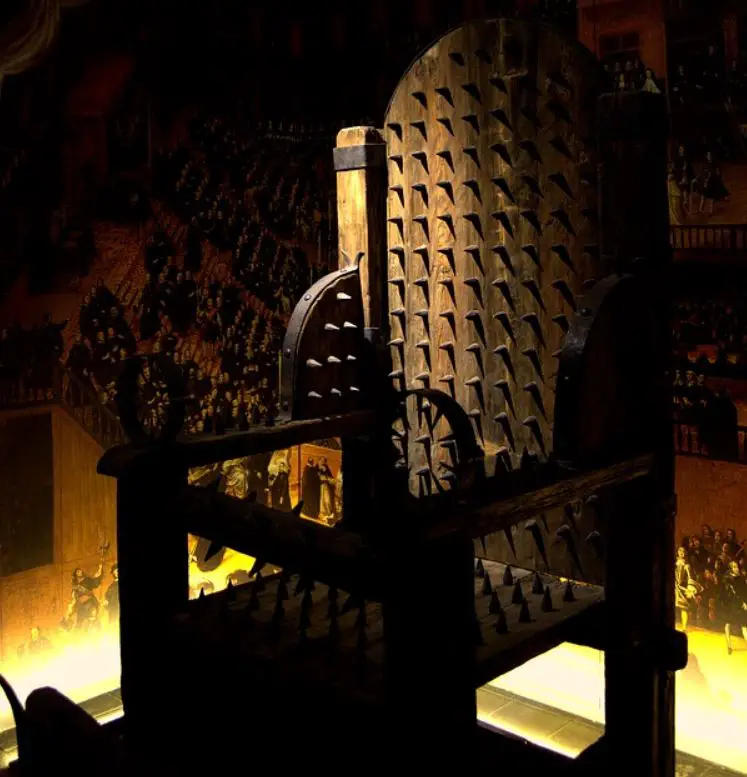The Middle-Ages. Those were the days weren’t they?
Not exactly if you intended to do crime or another mischief.
It’s not just a weird fact that the judicial system didn’t exactly believe in honest trials yet, it’s also a fact that most of the crimes committed were punished a bit harshly and often very humiliating.
And that’s putting it euphemistically in a major way.
Below you can find a medieval crimes and punishments list that will make most of the sentences handed out today look like a walk in the park.
1. Scold’s Bridle – Being Rude or Gossiping
We must admit that we sometimes can’t resist gossiping about somebody else. Well, in medieval times there was a torture method associated if you’re been caught doing it.
Important note: This was used on women and often they were also suspected of being witches so it was also often called the Witches’ Bridle.
The Scold’s Bridle was a metal mask type of device that disabled women from talking as they walked around in public.
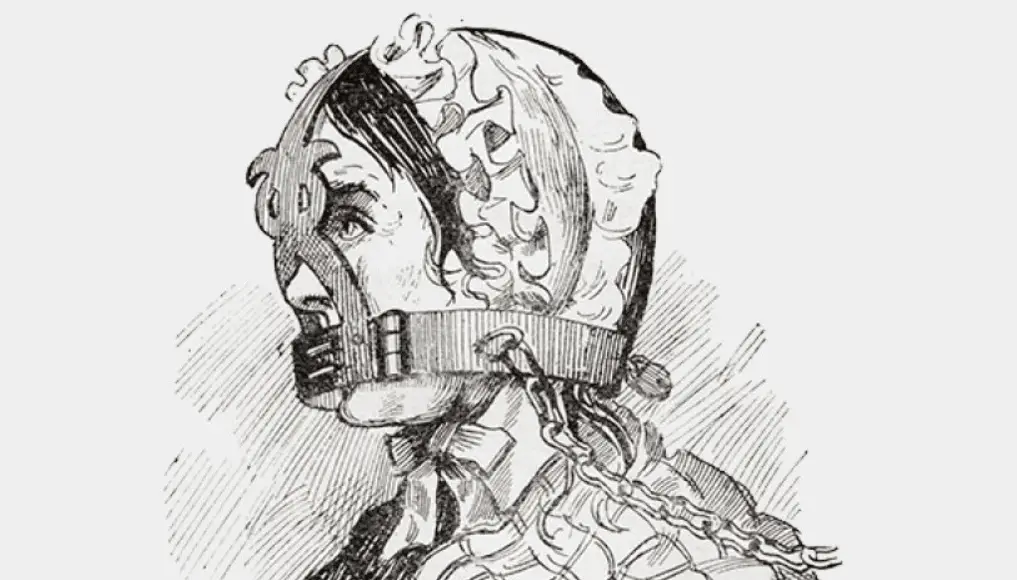
To make it even worse, a bridle-bit was pushed into the woman’s mouth causing severe discomfort and pain when wearing it.
Would this medieval punishment stop you from gossiping?
Modern day social media makes it possible.
2. The Stocks – Multiple Petty Crimes
In medieval times, humiliating a criminal was often used as a form of punishment.
Publicly displaying the offenders was part of everyday life in medieval times, and from around 1500 until at least 1748, the stocks were used for just this purpose.
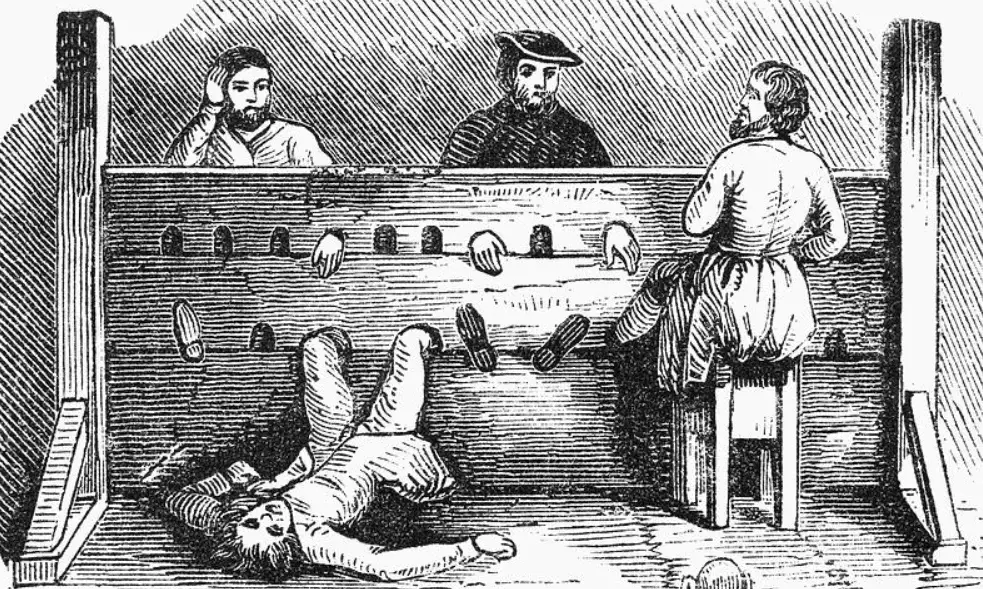
The stocks are restraining devices that disabled the use of a person’s feet. Therefore he could be tied down and subjected to other forms of humiliating acts as he was displayed publicly.
Spending a few days in these with rotten eggs constantly being thrown at you would surely make you think twice about doing the crime.
3. The Wooden Horse – Interrogation And Multiple Crimes
A particularly painful torture device, which was used mainly on prisoners to extract confessions (usually women accused of witchcraft) was the wooden horse.
There are accounts of men being sentenced to ride the wooden horse as well and it is used as a form of punishment.
The suspect was placed on top of a triangular device resembling a horse with a pointy edge. By being lower on the device with your full weight, it would cause immense pain.
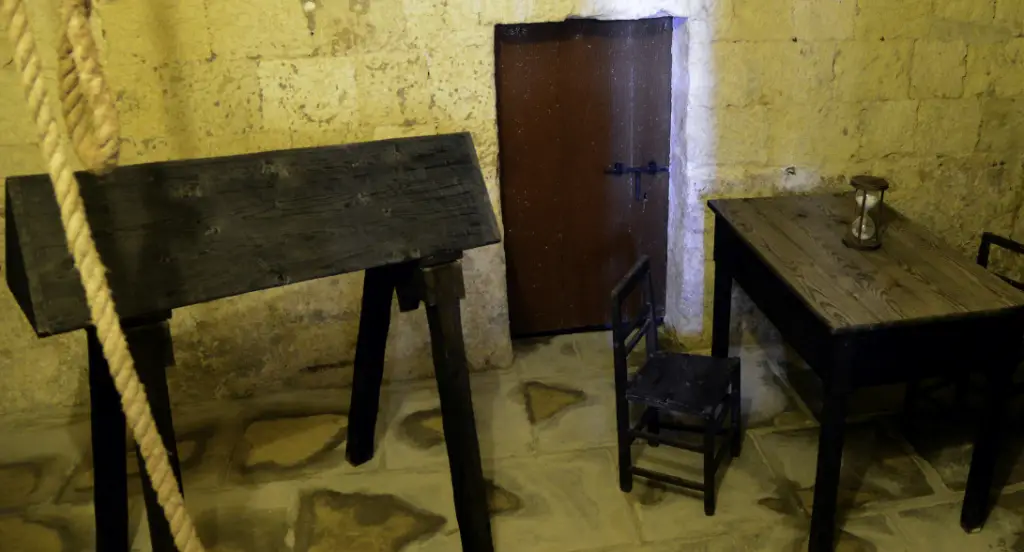
The wooden horse also referred to as the “Spanish Donkey”, was a very popular torture device during the Spanish Inquisition.
It was not unusual as well to add weights to the prisoner’s feet to increase the suffering.
It’s easy to imagine that a confession (true or not) wasn’t too far away when this torture device was used.
4. Breast Ripper – Adultery
In this day and age, the divorce rate in the world is somewhere between 20 and 60%. It’s fair to assume that a fair share of divorces is caused by adultery.
In medieval times, adultery was a high crime and published severely.
Proof of this?
An absolutely inhumane torture device called the breast ripper.
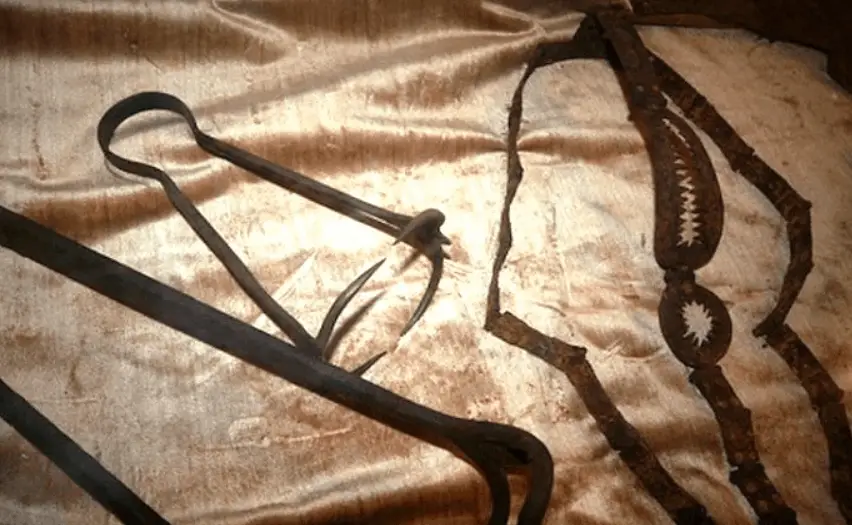
If a woman was found to cheat on her husband, her breasts would be strapped into this device and slowly being torn off.
Thinking of cheating on your husband when this awaits?
Probably not.
5. Pear Of Anguish – Adultery / Blasphemy
Talking about cheating, there was another torture device created for women who were sentenced to adultery in medieval times.
The pear of anguish is a metal-type device with a screw that allows it to expand in all directions.
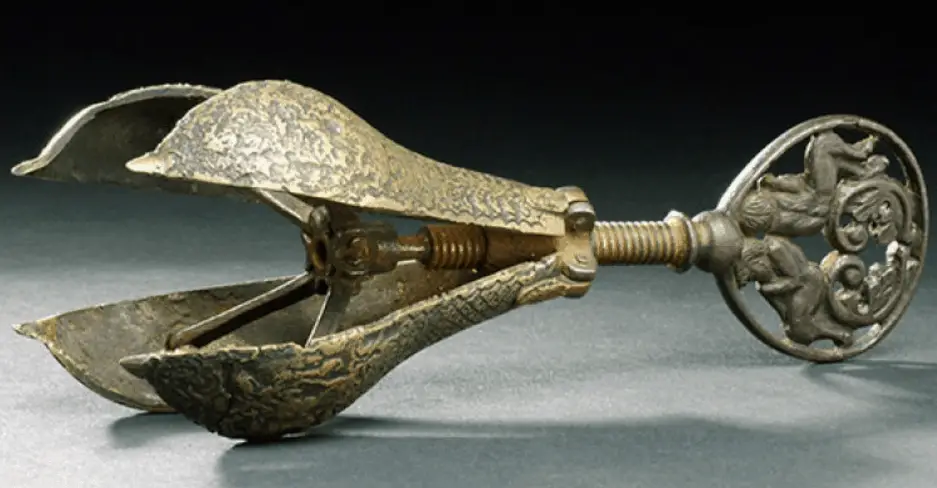
The device would be put in the vagina or anus of the woman sentenced and the screw would be turned until the metal tore apart the flesh. Sometimes, metal pins were attached to it to further increase the suffering.
Sometimes, this medieval torture device was also used if somebody was caught in the act of blasphemy, and then the device would be put inside the mouth with the same result to follow.
We can all see why the word anguish is being used to describe the
6. The Heretic’s Fork – Opposing The Catholic Church
We all know that the Catholic church didn’t take lightly people that didn’t agree with them during medieval times.
Special punishment for people that spoke out openly against the church was called the heretic’s fork.
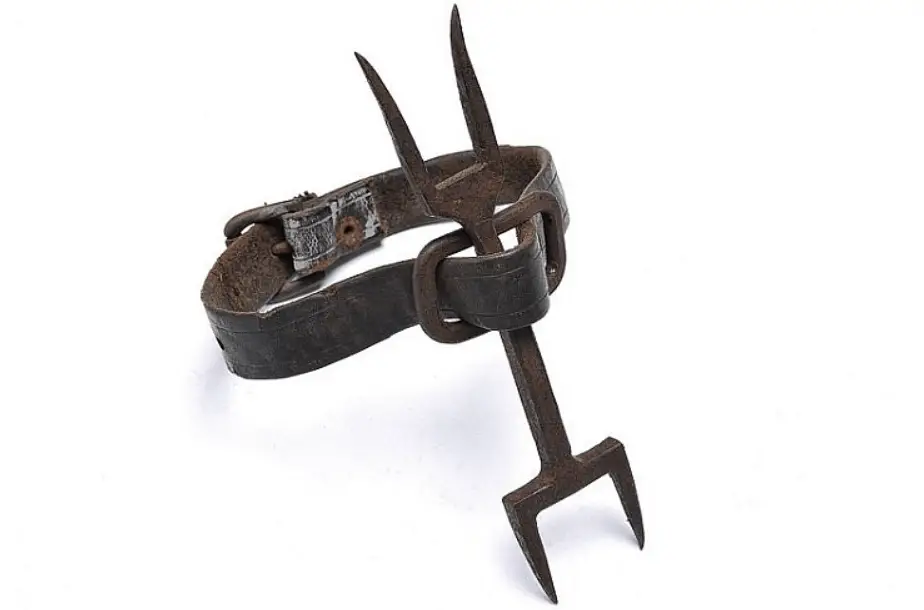
It had the word “Abiuro” engraved in it which simply means “I recant” in Latin. In other words, the punishment could be stopped whenever the sinner spoke those words.
A benefit?
Most definitely, but that didn’t mean everybody did as religion was a very serious business in those days.
Either way, the spikes that were pushing against the chin of the victims would cause severe pain with even a slight movement, they were not allowed to lie down and sleeping wasn’t permitted.
7. The Spanish Boot – Interrogation Of Prisoners
If you were an enemy and your captors wanted information, it was very likely that in medieval times you were presented with a new type of shoes.
This was not a gift under the Christmas tree or for your birthday, it was a torture device that literally crushed your foot until the bones were breaking.
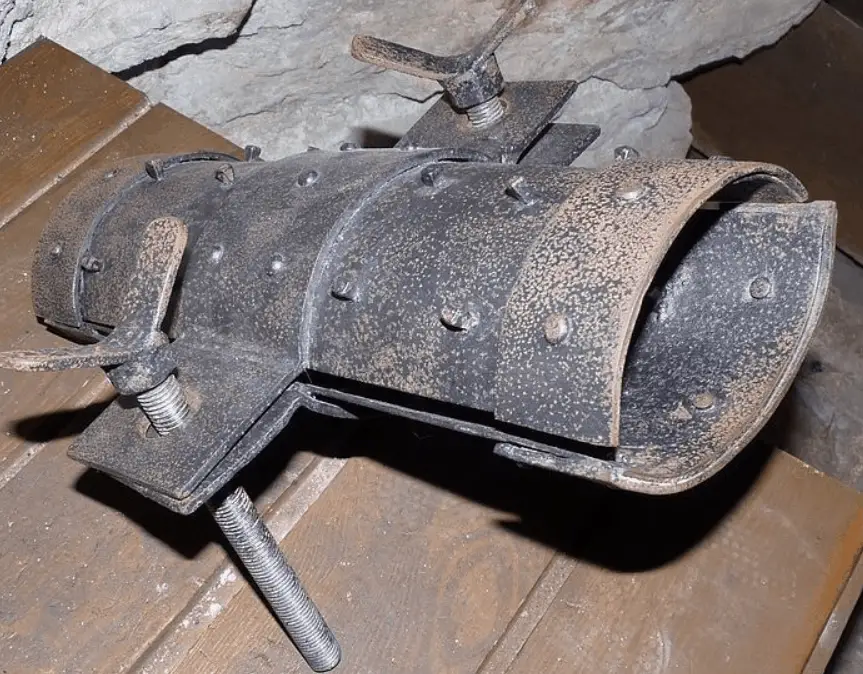
The foot of the victim was placed in the boot and the metal or wooden plates were screwed together with hinges.
There were two options:
- Either the pain was so immense that the victim lost consciousness
- The victim confessed and provided the information required
We think that this was a very effective way to get whatever information was needed, not only because of the pain it inflicted but also because it was used all over the world.
8. The Judas Cradle – Extracting Confessions / Information
Another way to extract confessions or information from opponents or prisoners was to strip them naked and lower them on a pyramid-formed chair. That’s why this device is also referred to as the Judas Chair.
The result: The victim was slowly being impaled.
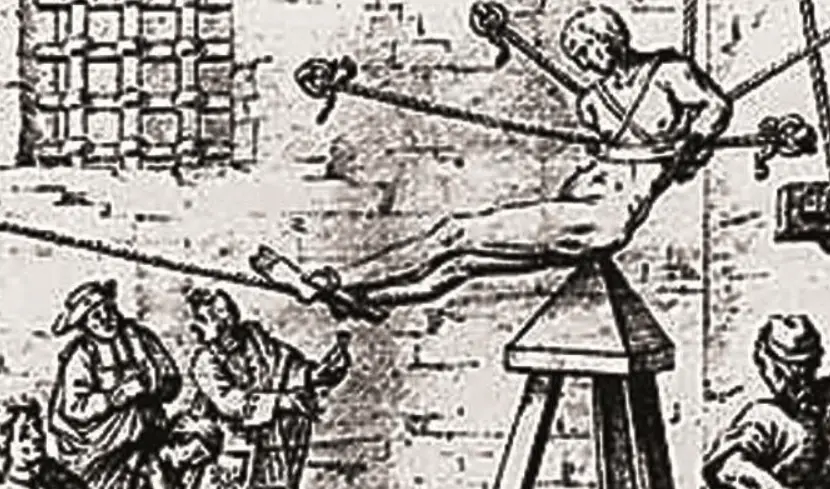
If the executioner felt like the victim wasn’t giving up enough information, they would be lifted and bounced back to increase the suffering.
The torture using this device could take several hours or even an entire day. If the executioner’s shift was over, he would simply lift the victim, let him hang there for the entire night, and continue in the morning.
Obviously, a task that didn’t include in the executioner’s job description was cleaning this horrible device, most probably causing the victim to die from infection if they made it out alive.
9. Pillory – Multiple Petty Crimes
During the Middle Ages, petty crimes were often punished by public displays of humiliation and suffering. One device used for this was the Pillory.
The Pillory was located on public squares or along the road, and the offender was placed with hands and head in the holes while bending forward, making it impossible to get out.

While this doesn’t seem like a very painful form of punishment, the unpleasant part came when the offender was abused by the people of the particular town.
Rotten eggs, rotten fruit, animal corpses, excrements, and all other sorts of undesirable things were thrown at the person strapped in the Pillory.
For more severe crimes, the crowd would turn to more harsh forms of punishment such as beating the person with sticks or throwing stones, sometimes causing severe injury or death.
In other words, you were basically at the mercy of the crowd while being immobilized inside the pillory.
10. The Rack – Extract Confessions
Extracting confessions from suspects in medieval times wasn’t quite handled the same way as it is now. While detectives try to extract confessions using psychology in current times, in medieval times multiple forms of physical torture were used to get a suspect to confess to a crime.
The result was that multiple times, innocent people confessed to crimes they didn’t commit in the first place.
When you were placed on the rack, a confession was almost certain.
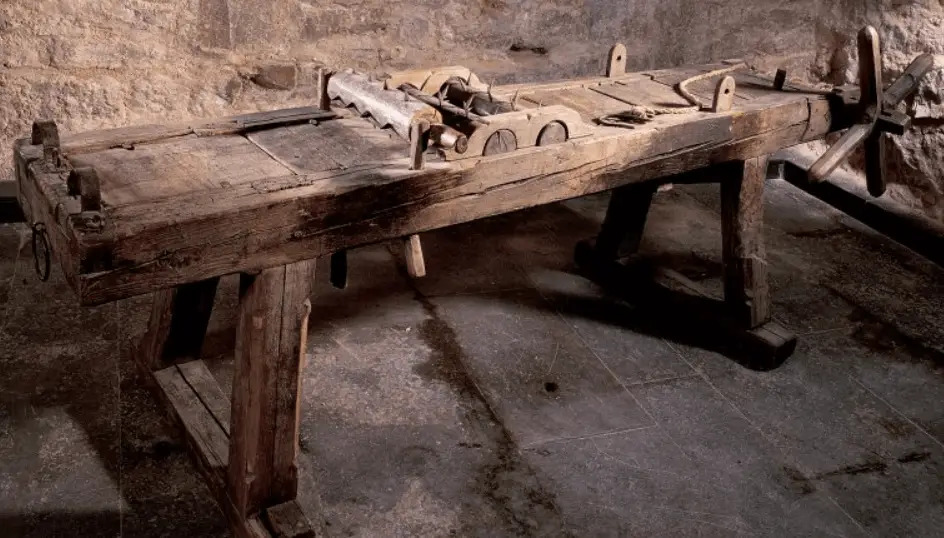
The suspect was placed on a wooden table with spikes sticking out of it and tied up on arms and legs with ropes. A roller would then allow the medieval detective to stretch the arms and legs of the suspect in such a way that it simply dislocates his limbs.
Obviously, this didn’t always happen, but if the suspect refused to talk, it wasn’t unusual for his limbs to be pulled from their sockets during the interrogation.
Very few methods would be more effective if you want a suspected criminal to talk.
11. The Knee Splitter – Interrogations During Spanish Inquisition
The knee splitter, as the name suggests, was intended to completely render a person’s knee useless.
Two planks with screws and pins sticking out of it would be attached to the knee until the pins penetrated the flesh of the accused.
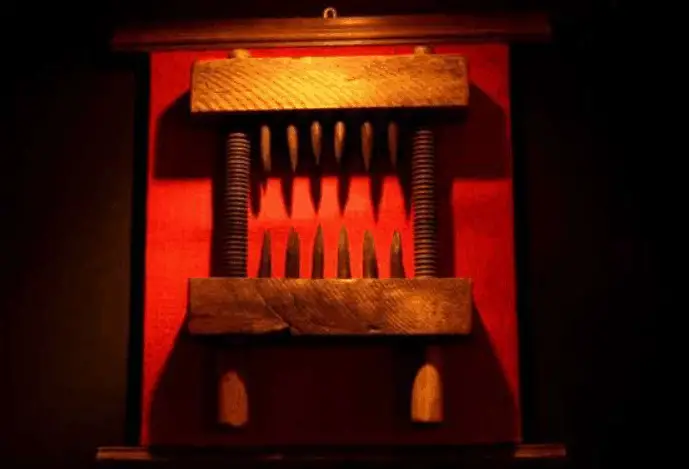
While slowly turning the screws further, the pins would then penetrate the bones of the person going through this ordeal until the ligaments were torn off and the bonus crushed, leaving the victim with permanent damage.
12. Foot Roasting – Extracting Confessions From Heretics
While being used throughout human history, roasting the feet of accused people has been used extensively in medieval times.
The accused would be put in a chair and immobilized at the feet, while fire would literally roast their feet until they confessed.

In 1307, the knight’s templars were arrested and foot roasting was one of the main torture techniques used to extra confessions.
While being very effective to get the needed confessions of the suspects, their fate wasn’t too much better as they were burned at the stake afterward.
When seeing what human beings were (and still are) capable of doing to each other, one might wonder if most of our lives aren’t pretty good.
I’m sure that this list of medieval crimes and punishments looks so dreadful that you will further appreciate the small things in your own life.
